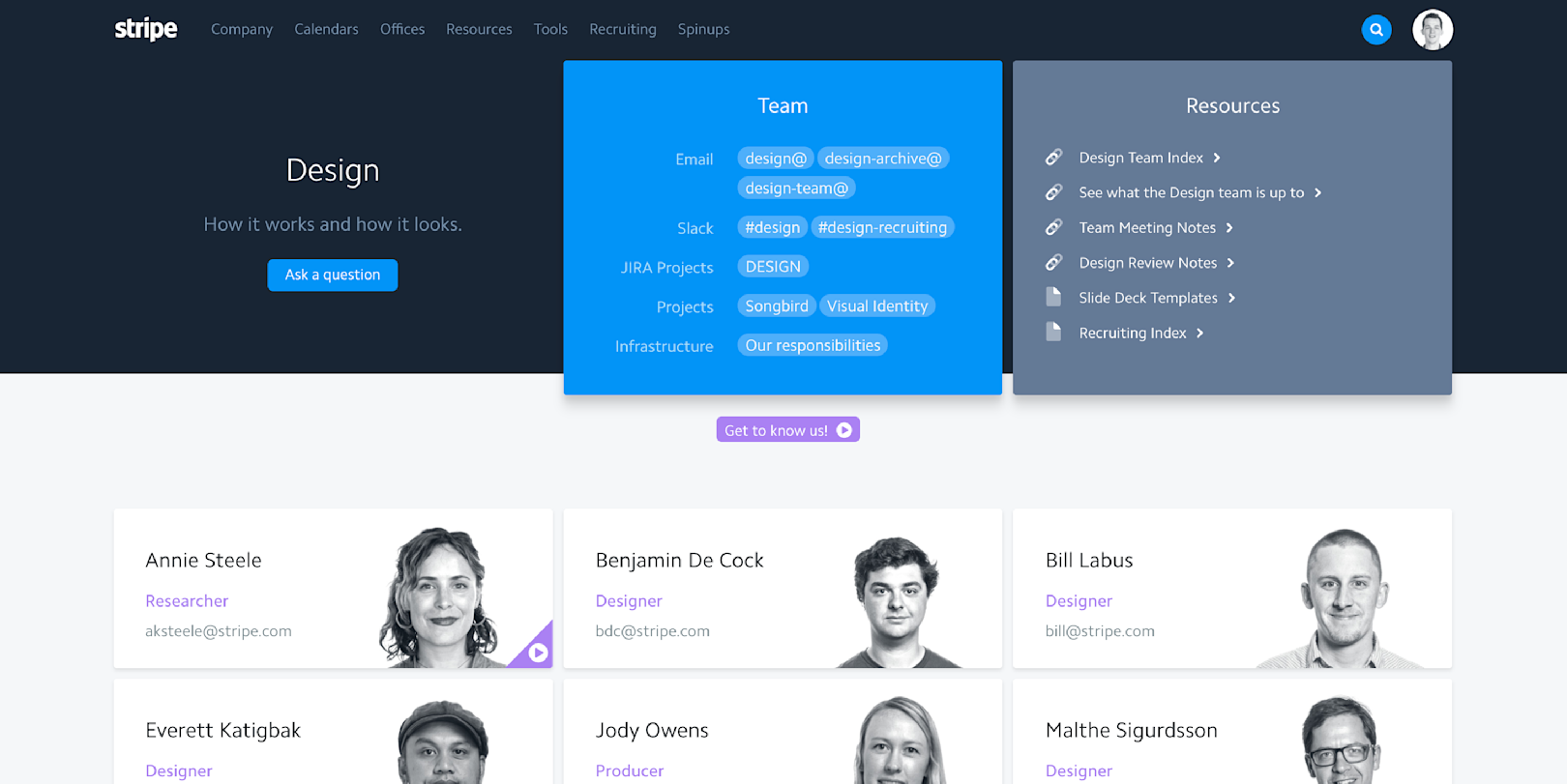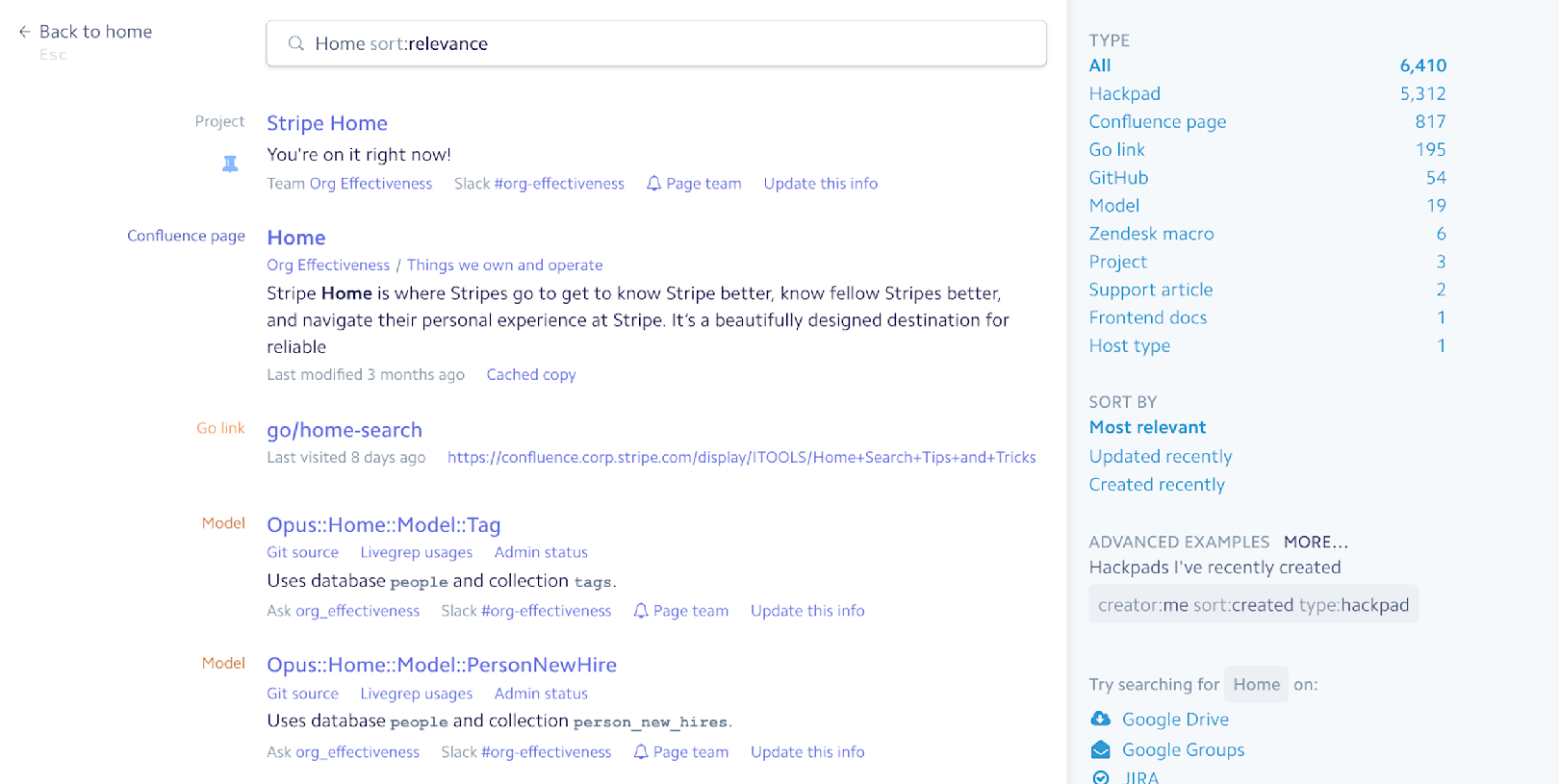Stripe Home
At Stripe, we’ve always been intentional about how we communicate, share information, and stay connected. Back when Stripe was smaller, it was easy for this to happen automatically. But by the time we hit around 150 people, it became hard to know everyone’s name. So at a company hackathon, a few Stripes created People, a directory to help Stripes meet and get to really know each other.
People focused on connecting individuals across the company: Stripes could set their own bios, create networks around common interests, and generally experiment with new ways to express who they are. People also gave us our first concept of a people API, which set the stage for automating our notification systems and made it quick to roll out new people-oriented features (like seating charts!).
We’ve since turned People turned into a full-fledged product called Home, weaving both how we know one another and share information beyond email into the same product. Used by 99% of Stripes in the last month, Home is the source of truth for who we are, what we’re doing, and why—and a platform for enabling individuals and helping them get to know one another.
Here’s a quick tour through a few Home highlights:
People worldwide
The people at Stripe are what bring and keep so many of us here, so we’ve made it easy to meet folks across the company. In the spirit of the original People, new Stripes are front and center on Home along with their own quick video introductions, a flipbook through existing Stripes (can you get their name right?), and activities happening around the company (ranging from classes we host to events for our users).
Home was also designed to encourage Stripes to get to know each person beyond their team and the projects they’re working on. We’ve found that building connections across the company makes it easier for us to share, learn from fresh perspectives and build a sense of belonging early on. Everyone has their own personal page that describes how to get ahold of them for work, where they work, and any quick background they’d like to share.
Home can’t paint the complete picture of the person behind the page, but it helps break the ice. Outside Home, we encourage people to meet in person—one of our more structured approaches involves a chat bot that helps schedule lunches among Stripes who are least likely to know each other (more than 5,000 lunches have been facilitated since it was set up!).
Multiple teams, one company
We don’t view teams as information silos or hard boundaries. Instead, we’ve designed teams to empower a group of individuals to take end-to-end ownership over an area and act autonomously toward their goals, while sharing lessons with the rest of Stripe. Helping teams share their knowledge to the company makes it easier for individuals at Stripe to find context that will both guide them in their work and help them learn above and beyond their role.
But with dozens of teams at Stripe, it’s tough to keep track of every area. To help, we built the team index as a central place to find any team at Stripe. Home randomly features teams and the individuals within them at the top to help keep Stripes aware. Individual team pages are like the people pages: they provide a common interface for getting ahold of the team, finding useful resources the team has shared, and even watching video introductions for the entire group at once. (We now have ten offices globally and built similar pages for those at a recent hackathon.)

Knowledge sharing
Individual Stripes collaborate—a lot. Last year we created more than 20,000 documents, ranging from email drafts to project proposals to canonical documentation relied on across the entire company.

Our search system lets Stripe look across documents, people, teams, and even API models, with live filters to help narrow the corpus quickly. The search interface is completely API-driven with modular content indexers underneath, so it’s easy to add new types of content to the same interface we use to find everything else. (API models were a recent addition.)
We still have a lot to do along these lines. Search satisfies the curious who know roughly what they’re looking for. Next up, we’d like to incorporate our canonical documentation into a structure that not only helps people browse and keep up with changes, but also helps Stripes find information they wouldn’t go hunting for on their own that would nevertheless benefit them (like lessons from another team’s retrospective).
Under the hood, Home is built on the same technology as our user-facing products (such as the Dashboard) because we wanted to make it easy to move between developing user-facing and internally-facing products. This has made Home a favorite for new Stripes’ spin-up projects and a popular go-to for Hackathon projects. The search feature described was built by a new class of Stripes as their very first project and office pages were built at our most recent hackathon.
Home is such an important part of how we work together and stay connected; it remains a work in progress along with Stripe as a whole. We’re still figuring out how to balance transparency with information overload, serendipity with curated content, and crisp interfaces and team boundaries with the actual human part that makes the company what it is. Our next projects are all about evolving knowledge discovery: from team pages that weave the individuals, metrics, and our users together to a better way to browse and publish information.



